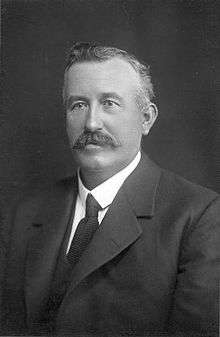Malcolm Cameron (Australian politician)
| Malcolm Cameron | |
|---|---|
 | |
| Member of the Australian Parliament for Barker | |
|
In office 16 December 1922 – 7 August 1934 | |
| Preceded by | John Livingston |
| Succeeded by | Archie Cameron |
| Personal details | |
| Born |
12 July 1873 German Creek, South Australia |
| Died |
1 March 1935 (aged 61) Glencoe, South Australia |
| Nationality | Australian |
| Political party |
Liberal (1922–25) Nationalist (1925–31) UAP (1931–34) |
Malcolm Duncan Cameron (12 July 1873 – 1 March 1935) was an Australian politician. He was a member of the Australian House of Representatives from 1922 to 1934, representing the electorate of Barker for the Liberal Party (1922-1925), Nationalist Party (1925-1931) and United Australia Party (1931-1934).[1]
Cameron was born at German Creek, where his father managed a pastoral property, and was educated at the Tantanoola school. He began farming at German Creek, before acquiring property at Glencoe when John Riddoch divided the former Glencoe Station.[2] He was clerk of the District Council of Tantanoola for twenty years, president of the local progress association, president of the Glencoe branch of the Agricultural Bureau, vice-president of the Mount Gambier Agricultural and Horticultural Society, and one of the key figures in the construction of the district hall and a member of its committee. He was credited with much of the responsibility for the development of the Glencoe railway line.[3][4] He was a prominent member of the Farmers and Producers Political Union and later served as president of the local branch of its successor, the Liberal Union.[5]
Cameron was elected to the House of Representatives at the 1922 federal election for the Liberal Party, a splinter group from the governing Nationalist Party. He had ousted the incumbent MP, John Livingston, in party preselection, after the party's Barker district committee voted to endorse him over Livingston without a plebiscite.[6] In 1925, along with his colleagues, he formally rejoined the Nationalist Party, which in turn became the United Australia Party in 1931.[1] He was re-elected at five successive elections, and served as a member of the Standing Committee on Public Works, including a stint as chairman. Cameron suffered a serious illness early in 1934, and though he initially recovered enough to be endorsed to stand again at the 1934 federal election, his illness recurred and he was forced to withdraw his candidacy in July and retire. He was confined to his bed for six months prior to his death in March 1935, and was buried at the Mount Gambier Cemetery.[3][2]
Notes
- 1 2 "Members of the House of Representatives since 1901". Parliamentary Handbook. Parliament of Australia. Archived from the original on 2007-12-25. Retrieved 2008-02-24.
- 1 2 "DEATH OF EX-LEGISLATOR.". The South Eastern Times. , (2893). South Australia. 5 March 1935. p. 2. Retrieved 15 October 2016 – via National Library of Australia.
- 1 2 "MR. M. D. CAMERON". Chronicle. LXXVII, (4,086). South Australia. 7 March 1935. p. 41. Retrieved 15 October 2016 – via National Library of Australia.
- ↑ "The District.". The Border Watch. 74, (7823). South Australia. 9 March 1935. p. 3. Retrieved 15 October 2016 – via National Library of Australia.
- ↑ "THE BARKER DISTRICT.". The Register (Adelaide). LXXXVII, (25,536). South Australia. 31 October 1922. p. 11. Retrieved 16 October 2016 – via National Library of Australia.
- ↑ "MR, LIVINGSTON TURNED DOWN.". The Border Watch. LXI, (6106). South Australia. 31 October 1922. p. 3. Retrieved 16 October 2016 – via National Library of Australia.
| Parliament of Australia | ||
|---|---|---|
| Preceded by John Livingston |
Member for Barker 1922 – 1934 |
Succeeded by Archie Cameron |